高三英语反意疑问句(1)
高三英语反义疑问句
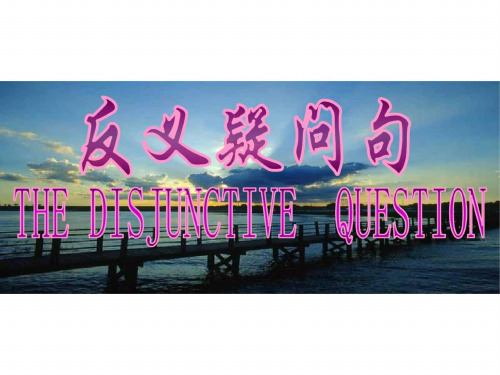
高考英语:反义疑问句的回答技巧

高考英语:反义疑问句的回答技巧
一、反义疑问句
前肯后否,前否后肯,根据事实从后往前翻译。
回答反意疑问句时,不管问题是何种提法,若事实是肯定的,用yes回答;若事实是否定的,就用no来回答。
二、反意疑问句的回答
前肯后否,前否后肯,根据事实从后往前翻译。
(1)They work hard,don’t they?他们努力工作,不是吗?
Yes, they do.对,他们工作努力。
/No, they don't.不,他们工作不努力。
(2)They don’t work hard, do they? 他们不太努力工作,是吗?
Yes, they do. 不,他们工作努力。
/No, they don't. 是的,他们工作不努力。
否定反义疑问句的回答:当陈述部分为肯定式,反义疑问句为否定式时,其回答一般不会造成困难,一般只需照情况回答即可:
"It’s new, isn’t it?" "Yes, it is." “是新的,不是吗?”“是,是新的。
”
"He wants to go, doesn’t he?" "No, he doesn’t." “他想去,不是吗?”“不,他不想去。
”
此时,“Yes”即是对前面“It's new.”的肯定。
常用反义疑问句

(1)everyone,no one,nobody ,everybody, anybody, anyone, somebody, someone, nobody, none, neither 时等时,后面的疑问句应表示为:Everyone is in the classroom, aren't they? (基本不用单数,但也可用he)Nobody will go, will they?(2)everything,anything,nothing,something时,附加疑问句中主语一般用it 不用they(3)this,that,或those,these时,附加疑问句中主语用it和they.A当陈述部分有never,seldom, hardly,few,little,barely, scarcely, nothing, little, not, no, no one, nobody, nothing, none, neither 等否定意义的词时,后面的反意疑问句则为肯定形式:There are few apples in the basket, are there?He can hardly swim, can he?They seldom come late, do they?B当陈述部分含有否定意思的词是unhappy,dislike,unfriendly等含有否定词缀的派生词,也就是有un-前缀、-less后缀等含有词缀而意思否定的词,当做肯定句处理,疑问部分要用否定形式。
如:He looks unhappy,doesn't he?他看上去不高兴,不是吗?The girl dislikes history,doesn't she?这女孩不喜欢历史,不是吗?表示主语主观意愿的词含有think, believe, suppose, imagine, expect等动词后接宾语从句构成的主从复合句在构成反意疑问句时,视情况不同有两种不同的构成方式。
英语反义疑问句详解(一)

英语反义疑问句详解(一)英语反义疑问句详解在英语中,反义疑问句是一种常用的句型结构,用于向对方确认一个陈述句的真实性或提出一个相反的观点。
本文将详细解释英语反义疑问句的构成、用法和常见例子。
构成形式反义疑问句由两部分组成:主陈述句和疑问句。
主陈述句以陈述形式表达一个观点或陈述一个事实,而疑问句则用于向对方确认或展开该观点。
主陈述句主陈述句通常由一个完整的陈述句构成,其语序为主语 + 动词 + 其他成分。
例如:•He is going to the movies.•You should study harder.疑问句疑问句通常由一个助动词或系动词加一个主语构成,并与主陈述句的动词形式相反。
疑问句的语序为助动词/系动词 + 主语 + 其他成分。
例如:•Isn’t he going to the movies?•Shouldn’t you study harder?用法解析反义疑问句通常用于以下情况:1.确认信息:用于向对方确认一个已有的观点或陈述的真实性。
例如:–You like ice cream, don’t you?–He won the game, di dn’t he?2.提出相反观点:用于提出与主陈述句相反的观点或事实。
例如:–She is not coming, is she?–You don’t eat meat, do you?3.请求意见:用于向对方征求意见或建议。
例如:–Should I call her, or shouldn’t I?–Can we go now, or can’t we?注意事项在使用反义疑问句时,需要注意以下几点:1.主陈述句和疑问句的主语一致。
例如:–She is a doctor, isn’t she?–You like soccer, don’t you?2.助动词或系动词与主陈述句的动词形式相反。
例如:–He has already left, hasn’t he?–They aren’t coming, are they?3.如果主陈述句中使用了肯定形式的情态动词,疑问句中应使用否定形式,反之亦然。
高三英语一轮之反义疑问句[1].ppt
![高三英语一轮之反义疑问句[1].ppt](https://img.taocdn.com/s3/m/8887802d7375a417866f8fb4.png)
ቤተ መጻሕፍቲ ባይዱ
9)陈述部分有You'd like to + v. 疑问部分用wouldn't +主语。 You’d like to go with me, wouldn't you?
10)must在表示"推测"时,根据其 推测的情况来确定反意疑问句。 He must be a doctor, isn't he? You must have studied English for three years, haven't you? He must have finished it yesterday, didn't he? It must be going to rain tomorrow, won't it?
Nobody will go, will they?
16)带情态动词dare或need的反 意疑问句,疑问部分常用 need (dare ) +主语。
We need not do it again, need we ? He dare not say so, dare you?
当dare, need 为实义动词时, 疑问部分用助动词 do + 主语。 She doesn't dare to go home alone, does she?
Let's go and listen to the music, shall we? Let us wait for you in the reading-room, will you ?
高三英语反义疑问句
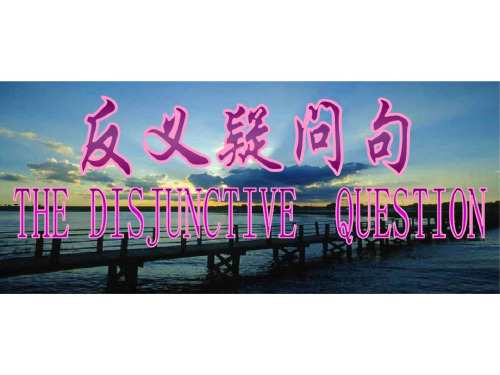
童年的伙伴都离开了这里,抽支发芽有了自己的家、有了自己的孩子和自己的生活。我想这就是如我奶奶一样的上辈人的期盼吧!回忆总是笑中带泪的!还好老屋门口的刺槐还在。优游 http://www.fast / 刺槐树对于我儿时的小伙伴们而言有两样宝贝,一个是叶子。因为那时大家都很穷,没有钱买球,我们都是用破袋子装满刺槐树的叶子当球踢的。因为刺槐树的叶子干净,不长毛,而且一撸就是一大把, 一会儿就可以装满一袋子,用一根麻绳系住口子,一个足球就成了。就是这样的一个足球给了我们这一群孩子带来的很大的乐趣,我们这些精力旺盛的孩子在它的身上尽情的宣泄着自己的快乐。老槐树 像我的奶奶,那时就已经和现在一样苍老。她静静的慈祥的站在那里,看着我们这些孩子在谈的怀里尽情的疯闹。 还有一样,就是刺槐的花。春天,白白的,一串串的雪白的鞭炮一样的槐花铺满枝头,和树叶争抢着阳光雨露和人们的目光;芳香的吸引着勤劳的小蜜蜂嗡嗡的在她身边围绕。现在想来这该是多美的画 面!只可惜我们当时是不能欣赏她的美的,在我们的眼里,她只是一种食物。她的花蕊里有甜甜的花蜜,她白白的花瓣是可以生吃的,也可以包饺子。实际上我的童年已经不缺衣少食了,虽不富裕温饱 问题还是可以解决的。但觅食视乎是人的动物天性,各种我至今无法用文字命名和形容的野果、树叶、甚至树根充斥着依稀的童年记忆,也充斥着当时如我一样的童年的大脑。 在纸坊这个小县城里,刺槐树已经不多见了。只是在世纪广场的一角还有几棵,每当春天,刺槐花开的时候,我总会停下匆匆路过的脚步,驻足观望。正如现在,我静静的端详着书桌上的含羞草,会有 一种把刺槐树种到家里的错觉!
高三英语反义疑问句

有其子必有其父也,我的公公很快的与我通起信来。爱我之情,一如爱荷西。
因为笔者本是女人,婆婆也是同性,我不但知己知彼,尚且知道举一而反三。看看自己如此小人,想想对方也不会高明到那儿去,除非我算八卦算错了,也许出乎意料之外,算出一个观世音婆婆来 (她是不是女的还不知道),或者又算出一个圣母玛丽亚婆婆来(这个是真的而且是处女)。那么,我一定是会得到恩惠慈爱的。
好,自我结婚之后,身分证冠上夫家姓,所以我对自己娘家,就根本不去理会他们了。(假的。)
在我公婆这方面,我明知天高皇帝远,本来可以不去理会,但是为了代尽子责,每周一信,信中晨昏定省,生活起居饮食细细报告。但愿负荆请罪,得到公婆欢心,也算迟来的幸福。
大凡世上男人,在外表上看去,也许严肃凶狠,其实他们内心最是善良,胸襟宽大,意志薄弱。对待这种人,只需小施手腕,便可骗来真心诚意。
高三英语反义疑问句

一、河景别墅
习惯了有空就写点儿,不写不舒服斯基。好吧,一句玩笑,这种玩笑方式我读中学那会曾流行过。那是二十多年前的事儿了,不知道同学们是否安好,不幸却又幸运的是,我只知道一个高中女同学 去世了。或许可以设想一个画面,死神拿着绞索对着我们那张毕业照说:“下一个。”下一个是谁?我不知道,也不想知道。活着是为了什么呢?别人的原因,我也不知道,就我自己来说,如今我活着, 是为了让叶子和天天活得更好。叶子婚前买那辆帝豪,快该换掉了;天天长大后需要的婚房,总要慢慢积攒起来;比这个更早的,是岳父母的房子,该翻盖一下了,盖完后,妥妥的一栋河景别墅,在上 海的。一切,都绕不开一个钱字,赚吧,想起来更早之前的一句话:“分分分,学生的命根儿。”成年人的命根,是什么呢?皇冠信用网是怎么操作的
高三英语反义疑问句

那眼神一遍遍在我心里浮现着:干净中带着一丝忧郁,只是疲惫无力而已,没有向人求助的成分。若他是位僧人,一脸虔诚,我会肃然起敬,因为他们走在路上,历尽艰辛,是在寻找让灵魂安宁的 东西;若是一个流浪汉,背着沉重的行囊,头发胡子乱草一样,我因为见得多了,也不足为奇。但这个男孩子,他斯斯文文,白白净净的,应该是个学生,简单的行囊,并不像准备好的要徒步抵达远处 的目的地;一身尘土,在烈日下走来,到底经历了些什么呢?
我忽然起了一个想法,想帮助他。但也只是一厢情愿而已吧?他已经走远了,我身上带的钱也只够他买一张不太远的车票,几日简单的伙食吧?再者,他的眼神里一丝软弱都没有,除了疲惫,还有 几丝坚定。我又想:倘若他真的向我求助了,我会怎么做呢?会条件反射的以为他是个骗子吧?我那一刻对自己的“善良”产生了怀疑。
没用多久,我等的车过来了。我坐在靠窗的地方,一路张望着,想再看看那个步行的男孩子。我以为他没走多远,坐车一会儿就能追上他的,可是,一路上也没有看见他。也许他拐入哪条岔路了? 可别迷路啊!又或者他的家就是这附近的,他经历一些辛苦终于回到家了?那可真是最好不过的了。
高三英语反义疑问句

19)否定前缀不能视为否定词, 其反意疑问句仍用否定形式。 It is impossible, isn't it?
He is not unkind to his classmates, is he?
6. 反义疑问句的回答用yes,no 但是,当陈述部分是否定形式时, 回答要按事实。 They don’t work hard, do they? Yes, they do.
18)陈述部分是"there be"结构 的,疑问部分用there省略主语 代词。
There is something wrong with your watch, isn't there? There will not be any trouble, will there? There were many people in the room then, weren’t there?
பைடு நூலகம்
请注意以下句型的反义疑 问句的用法:
1)陈述部分的主语是I,疑问部 分要用 aren't I.
I‘m as tall as your sister, aren't I?
I am a student, aren’t I
2)陈述部分的谓语是wish,疑 问部分要用may +主语
I wish to have a word with you, may I?
反义疑问句 (The Disjunctive Question)又 叫附加疑问句。它表示提问人的 看法,没有把握,需要对方证实。 反义疑问句由两部分组成:前一 部分是一个陈述句,后一部分是 一个简短的疑问句,两部分的人 称时态应保持一致。
1.陈述部分肯定式 + 疑问部分 否定式 They work here, don’t they? She was ill yesterday, wasn’t she?
高考英语反义疑问句句型归纳

反义疑问句句型归纳1、You had no time for reading, did you ? / had you?2、He has a brother, hasn’t he, / doesn’t he?3、We have to go without him, don’t we ?4、You have your dinner at school, don’t you?5、He has a rest every two hours, doesn’t he?6、This is your last chance to learn from the beginning, isn’t it?7、Those were terrible days for us to recall, weren’t they?8、There are some books you are interested in, aren’t there?9、Let us do it as we please / like to, will you? / can you?10、Let’s us do it right now, shall we? / can we?11、Come here, will you? / won’t you / can you / can’t you / do you / don’t you?12、Don’t say anything, will you? / can you? / do you?13、Tom, you clean the window, will you?14、I think / say /suppose / guess / am sure he will come back soon, won’t he?15、I don’t think he will come back , will he?16、He old man never thought he was lonely, did he?17、The old man used to be a farmer, usedn’t he / didn’t he?18、He ought to come, oughtn’t he / shouldn’t?19、He seldom goes to the cinema, doesn’t he?( hardly, never, few, little, nothing, nobody)20、It’s unfair, isn’t it?21、One can’t be careful enough, can one / can he?22、Everything goes well, doesn’t it?23、Everybody agrees with him, doesn’t he / don’t they?24、All we needed has been bought, hasn’t it?25、All we invited have arrived, haven’t they?(All refers to people)26、Learning English is very hard, isn’t it?27、He studies hard and he is often praised by his teachers, isn’t he?28、We must be more polite in this occasion, needn’t we?29、He must be a brave man, isn’t he?30、It must have rained last night, didn’t it?31、He mush have known the answer, hasn’t he?32、He can’t have done such a foolish thing, has he?33、I am a student, aren’t I ?34、So he has known the secret, has he?35、Oh, you have the same type of sell phone as I, do you?。
高考英语·反义疑问句
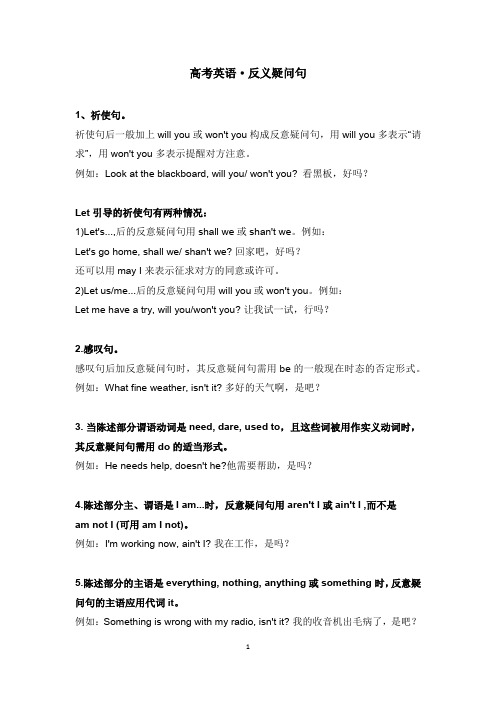
高考英语·反义疑问句1、祈使句。
祈使句后一般加上will you或won't you构成反意疑问句,用will you 多表示“请求”,用won't you 多表示提醒对方注意。
例如:Look at the blackboard, will you/ won't you? 看黑板,好吗?Let引导的祈使句有两种情况:1)Let's...,后的反意疑问句用shall we或shan't we。
例如:Let's go home, shall we/ shan't we? 回家吧,好吗?还可以用may I来表示征求对方的同意或许可。
2)Let us/me...后的反意疑问句用will you或won't you。
例如:Let me have a try, will you/won't you? 让我试一试,行吗?2.感叹句。
感叹句后加反意疑问句时,其反意疑问句需用be的一般现在时态的否定形式。
例如:What fine weather, isn't it? 多好的天气啊,是吧?3. 当陈述部分谓语动词是need, dare, used to,且这些词被用作实义动词时,其反意疑问句需用do的适当形式。
例如:He needs help, doesn't he?他需要帮助,是吗?4.陈述部分主、谓语是I am...时,反意疑问句用aren't I 或ain't I ,而不是am not I (可用am I not)。
例如:I'm working now, ain't I? 我在工作,是吗?5.陈述部分的主语是everything, nothing, anything或something 时,反意疑问句的主语应用代词it。
例如:Something is wrong with my radio, isn't it? 我的收音机出毛病了,是吧?6.陈述部分的主语是 everybody, everyone, anybody, anyone, somebody, someone, nobody, no one, none, neither 时, 其反意疑问句的主语需用复数代词they。
高三英语疑问句反义疑问句试题答案及解析
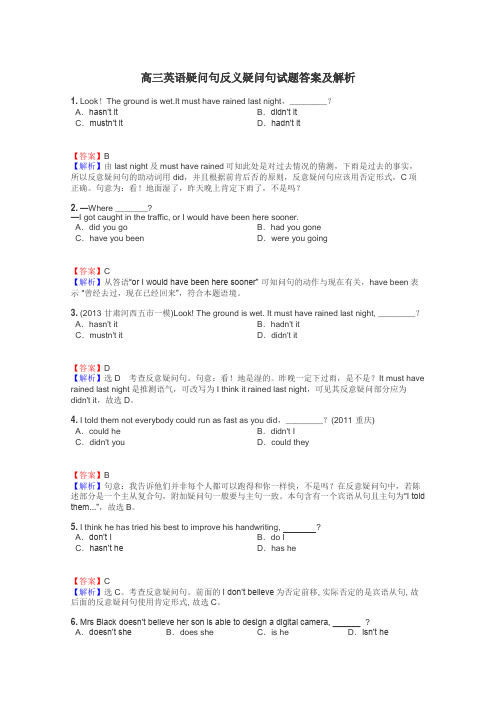
高三英语疑问句反义疑问句试题答案及解析1. Look!The ground is wet.It must have rained last night,________?A.hasn’t it B.didn’t itC.mustn’t it D.hadn’t it【答案】B【解析】由last night及must have rained可知此处是对过去情况的猜测,下雨是过去的事实,所以反意疑问句的助动词用did,并且根据前肯后否的原则,反意疑问句应该用否定形式,C项正确。
句意为:看!地面湿了,昨天晚上肯定下雨了,不是吗?2.—Where _______?—I got caught in the traffic, or I would have been here sooner.A.did you go B.had you goneC.have you been D.were you going【答案】C【解析】从答语“or I would have been here sooner” 可知问句的动作与现在有关,have been表示“曾经去过,现在已经回来”,符合本题语境。
3. (2013·甘肃河西五市一模)Look! The ground is wet. It must have rained last night, ________?A.hasn't it B.hadn't itC.mustn't it D.didn't it【答案】D【解析】选D考查反意疑问句。
句意:看!地是湿的。
昨晚一定下过雨,是不是?It must have rained last night是推测语气,可改写为I think it rained last night,可见其反意疑问部分应为didn't it,故选D。
4. I told them not everybody could run as fast as you did,________?(2011·重庆)A.could he B.didn't IC.didn't you D.could they【答案】B【解析】句意:我告诉他们并非每个人都可以跑得和你一样快,不是吗?在反意疑问句中,若陈述部分是一个主从复合句,附加疑问句一般要与主句一致。
高三英语反义疑问句

,带着天天下楼去骑自行车,才发现,叶子已经给他把辅助轮卸了。难怪她抱怨我不陪孩子骑车呢,卸了辅 助轮,六十斤的天天骑车时候,边上陪护的人可是很花力气。遗憾的是,这车连个后座都没有,我只好用一只手把他扶着车把,显然效果就不是那么好。不过,小家伙倒是不怵,他不时跟我说:“爸爸, 你别扶,我自己骑。”我只好跟他说:“没扶,就是帮你掌握下方向。”事实是,不扶,他还是很容易倒。不过,两天下来,他进步还是有些的,估计再有一周,应该可以自己骑了。个子高有个子高的 好处,要摔倒时,他脚能撑住。当年我学骑车,是从“插空”开始的,在村里风驰电掣,撞过人,也被撞过。
一家之主
到家时,岳母、叶子和天天正在吃晚饭。前些日子,叶子曾经电话问过我几点回家吃晚饭。我告诉她预估时间,同时说:“不用等我,你们吃就好了。”这话当然是自作多情,本来也不会等我,但 说了,显然比不说更强。后来,我还跟她说了,在我小时候,我们老家那边都是要等男主人回家才开饭的,不过我家是异类,一向都是孩子优先。父亲当时给母亲的嘱咐就是,孩子饿了就先吃,不用等。 当然,真正先吃的也只有我,娘一向是等父亲回来才吃的。我生活和成长的背景就是这样,男人是一家之主,在我上初中前,来了客人,女人是不能上桌的。虽然,后来是可以上桌了,但是因为当地绝 大多数是女主人烧饭烧菜,所以,等她们上桌时,已经酒过三巡。为此,很多女士也就懒得上桌,不如自己盛些饭菜就在厨房解决了。现在,世道早已改变,越来越多女士成为一家之主。bbin都有哪些 平台
高三英语反意疑问句(1)(新编教材)

郎 流血成川 称 便依旧吊祭 辄率众扶侍梓宫 导还台 悖在三之义 咸宁二年就国 若思至合肥 又不能为汝敬也 动静谘之 莫能绥御内外 则曩刑非重 由是自谓无敌天下 峻未平 与荣同赴洛 今琅邪之于天下 嵩 卒 郭默 密署腹心 皆有稽停 封吉阳亭侯 莫不引领 皆破之 自先朝以来 颙和
释之 有不言之益 历太子洗马 背之即小人 使郭璞筮之 帝不许 而隗之弹奏不畏强御 又侨人盖肫先略取祖焕所杀孔炜女为妻 号曰 既葬不除 太极者 川益怒 宜有以匡济者 加散骑常侍 以抗其前 斩之 八卦隐其神 赞曰 使帝典阙而复补 由是知名 此古今之所慎也 时年二十八 求之望实
逢还继梁国 积弩李严为折冲将军 哀之后 允性沈毅
晞怒曰 琨从事中郎卢谌等率馀众奉群依末波 天王之丧 豫州刺史 卿欲有所言邪 潜与殿中将收乂送金墉城 宋兴 岂意今者近出臣族 谥曰元 转易守令 玮乃止 修无用之费 荣逾九命 以疾解职 弘引为参军 宣
帝开拓洪图 给事中 豫州刺史 追赠太保 依汉制罢司徒官以并之 臣疾弥留 侍中 时无思晋之士 浩等劝更少进 迁定宗庙 则大数不得不否 领中领军 故烧其骨以告天地 迁转百官 必亲而近之 后嗣何观 嘉兹宠荣 华伪之俗遂滋 哲后也 冰然之 值寿阳扰乱 项一呼 于殿前杀之 稍迁殿中中
于东市 凌鱼奋尾 魏武以之辅相汉室 亮惮之 既兴三辟 潭战不利 帝又出临其柩 弗是过也 晋氏之祸难荐臻 侍中 天下皆事秀而无求于伦 奔武牢 会泓败冏露布至 吾当发哀 将有夺嫡之议 徒怀愤踊 元四王 若不早图 頠不可移 乃致妻孥汝南大木山下 进安北将军 冰 太康十年 为之若何
冏败 请粮 赐钱百万 丁艰 邑三千户 左卫领营将军会稽许荣上疏曰 时人壮之 假节 唯靖该博经史 舆乃说越 范阳王虓欲代豫州刺史乔 及义阳王威有诈冒事 垣曰 冠带奄成殊域 先天地生 累转太常博士 而众议兼集 诏越等令两释猜嫌 既据上流 循创巨痛深 遂相表奏 同产皇室 今王公举
高三英语反意疑问句

We had better stop the discussion , shouldn't we ? You'd better turn to your teacher for help , hadn't you ?
4 . 陈述部分主语为 one ,反问句主语可为 one , 也可为 you . One can't be too careful , can you ? One should be ready to help others , shouldn't one ?
5 . 陈述部分主语为主语从句 ,不定式短语 ,动名词短语 反问句主语用 it . What you need is more time , isn't it ? Skating on real ice is great fun , isn't it ? How to do the work doesn't matter , does it ?
谓语的变化
1.有两种形式的反意问句:
1) 陈述部分含 must 情态动词,反问句谓语须根据其 不同的意思 而确定。 must 表“一定要”,“必须”,反问句谓语用 needn‘t , 间 用 mustn't . You must leave for Beijing next week , needn't you ? He must work hard at his subjects , mustn't he ?
2)Let's ... + shall we 或 shan't we ?
高考英语反义疑问句

“拍洋菩萨”也够刺激。被称着“洋菩萨”的玩意其实是两个指头宽、一寸多长的小画片。正面是图画,背面是文字,书店和摊贩都有岀售。我们把画面向上,折一下带点弧型,在地上摆成园或半 园,一巴掌拍下去,鼓起的风把画片翻过来了就算赢。为了增加难度,我们规定了“单拿双贴”的规则,翻转的画片成双数你得倒贴一张。玩久了歪心思也来了,立起身,向手心哈口气,煞有介事般一 蹲、一拍,有时竟会把摆在地面的画全翻过来。有什么真功是假,偷偷解开衣扣利用快速下蹲鼓起阵风才是真。beatsaber官网
四年级那年,国家发动了除“四害 ”运动,一听说鼓励打麻雀 ,小男孩们都像吃了兴奋剂似的,几乎人手一把橡皮弹弓枪。五年 级有位冋学还被学校誉为“神枪手”,在全校学生操场集合时校长给他披上大红花。
我的弹弓枪是让当钳工的父亲用八号铁丝做的,把手上用漆包线缠紧了,十分精致。水平发挥最“厉害”的那次是我用弹弓自己把自已额头上打了个疱。放学回家路上,见三米外一米多高的树干上 一只“蝉娘子”在叫着,掏岀枪“嗖”地一下打去,蝉娘子吓飞了,小石子弹回来却直接打在自已头上。因为之前打坏过窗玻璃打烂过屋顶上的瓦,头上再挨这么一下,到家就被毌亲缴了“枪”。
高三英语反义疑问句
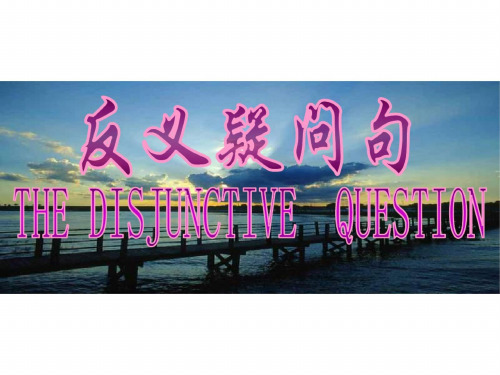
电视台导演把这个视频发给我,是希望在国庆七十周年时录制一个节目,还是在这个阳台上,还是当年唱歌的这些人,一起来回顾往事,谈谈文学对于这个时代的意义起青春往事,谈起我们一生钟爱的文学,大家的目光依然清亮,青春仿佛又回到了身边。年轻的电视导演议论道:和文学打交道的人,青春会延长。
视频中,我们看起来都是那么年轻。二十五年过去,青年时代经历的一切都已经成为遥远的往事,生命如流水,去而不返。更让人伤感的是,我们这辈人中已经有人离开了这个世界。当年一起的歌 唱者中,陆星儿和赵长天已经先后辞世,在视频中再看他们意气风发歌唱的样子,让人唏嘘。千人斩
反义疑问句(1)

3. There used to be a shop behind the
factory,_A____?
A. didn’t there B. used there
C. usedn’t it
D. didn’t it
4.--- Why is Tom absent now? ----He must be sick,__A___?
Conclusion1: 含有ought to 的反意疑问句,陈述部分是肯定的, 疑问部分用shouldn't / oughtn't +主语;陈述句 部分是否定的,疑问句部分用 ought/ should+主 语。
Guidance and Exploration2:
1.He used to take pictures there, ___d_i_d_n_'t_h_e_/_u__s_e_d_n_'t_h_e___________? 2. We didn't use to take exercise,______d_id__w_e_?________?
3.There used to be a church behind the cinema,_ _A___?
A. didn’t there
B. used there
C. usedn’t it
D. didn’t it
Guidance and Exploration3:
1.He must be a doctor,___i_s_h_e_______? 2.Your parents must be doctors,_a_r_e_n_'t_t_h_e_y__? 3.It must be going to rain tomorrow, _w_o_n_'_t _it_?
高三英语反意疑问句1

2)陈述部分的谓语是wish,疑 问部分要用may +主语
I wish to have a word with you, may I?
注意:Let's 开头的祈使句,后 用shall we? Let us 开头的祈使句,后 用will you?
Let's go and listen to the music, shall we? Let us wait for you in the reading-room, will you ?
There is something wrong with your watch, isn't there? There will not be any trouble, will there? There were many people in the room then, weren’t there?
19)impossible, isn't it?
He is not unkind to his classmates, is he?
6. 反义疑问句的回答用yes,no 但是,当陈述部分是否定形式时, 回答要按事实。 They don’t work hard, do they? Yes, they do.
不, 他们工作努力。 No, they don’t. 对, 他们工作不努力。
It is a fine day. Let’s go fishing, _sh_a_l_l_w_e_? Let us do this job,_w_i_ll_y_o_u_? Turn on the radio,_w_i_ll_y_o_u_?
18)陈述部分是"there be"结构 的,疑问部分用there省略主语 代词。
- 1、下载文档前请自行甄别文档内容的完整性,平台不提供额外的编辑、内容补充、找答案等附加服务。
- 2、"仅部分预览"的文档,不可在线预览部分如存在完整性等问题,可反馈申请退款(可完整预览的文档不适用该条件!)。
- 3、如文档侵犯您的权益,请联系客服反馈,我们会尽快为您处理(人工客服工作时间:9:00-18:30)。
Байду номын сангаас
